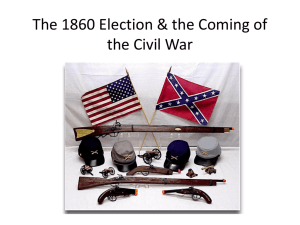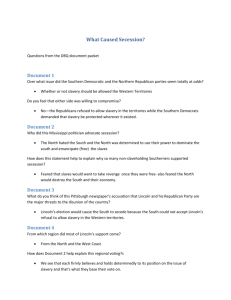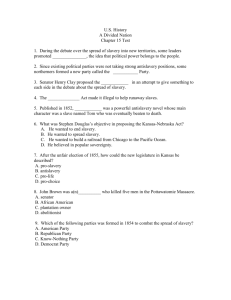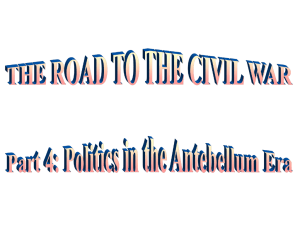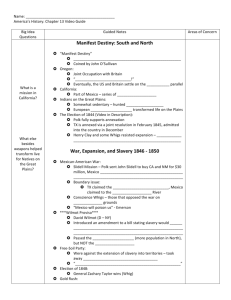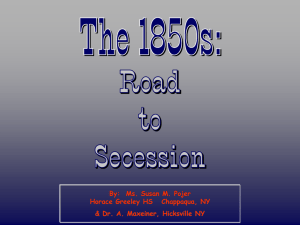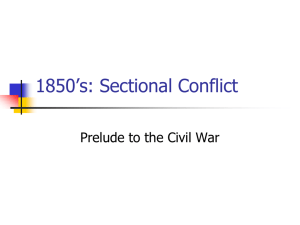Causes of Civil War
advertisement
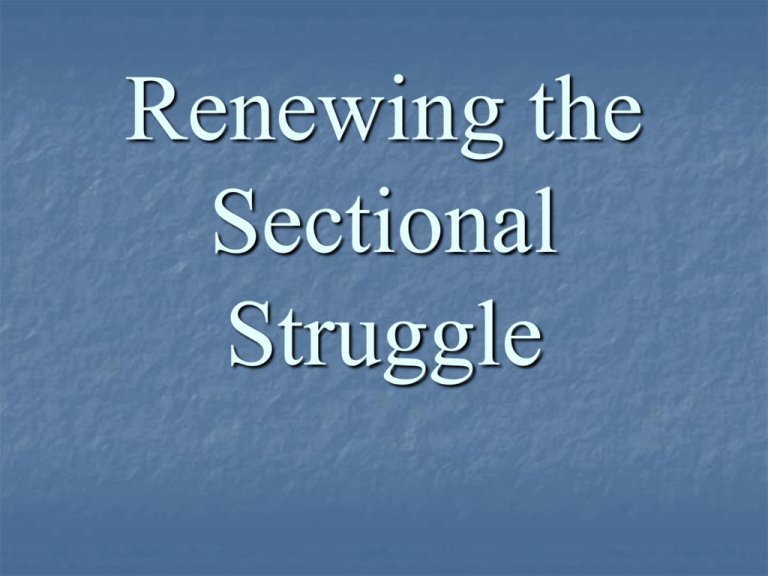
Renewing the Sectional Struggle Overview: Controversies over slavery in the territories along with the influx of immigrants in America contributed to the splintering of old political parties (Whigs) and the emergence of new parties (Republicans / American). Political Parties were forming and dissolving in the 1840s and 1850s Parties (1840s and 1850s) Section of country where most lived Slavery in exist. States? Slavery in terr.? Popular sovereignty? Immigration? Whig Mainly Easterners Split on this issue NO NO Not a party policy Democrat Mixed at first, mainly Southerners by 1850s Split at first, then proslavery as it became southern YES YES Not a party concern at this time American “KnowNothing” All sections Split (but antiBlack) NOT A FOCUS NOT A FOCUS Antiimmigration and antiCatholic Repub. North, East Anti-, but not abolitionist (Northern party) NO NO Liberal Policy The “Know-Nothings” [The American Party] Nativists. Anti-Catholics. Anti-immigrants. 1849 Secret Order of the Star-Spangled Banner created in NYC. Angered by the tactics employed by defenders of slavery, anti-slavery factions emerged ELECTION OF 1844 - “Territorial Expansion” OR/TX/CA Whigs: Henry Clay vs. Democrat: James K. Polk Liberty Party (Universal emancipation achieved gradually by law) 1844: James G. Birney -Drew votes from Whigs (NY) ELECTION OF 1848 - “Slavery issue” - New terr. Whigs: Zachary Taylor “Old Rough and Ready” vs. Democrat: Lewis Cass Free Soil Party (Not abolitionist - opposed terr. expansion of slavery) 1848: Martin Van Buren “Free Soil, Free Labor, Free Men!” -Drew votes from Democrats Free Soil Party Free Soil! Free Speech! Free Labor! Free Men! “Barnburners” – discontented northern Democrats. Anti-slave members of the Liberty and Whig Parties. Opposition to the extension of slavery in the new territories! WHY? The 1848 Presidential Election Results √ Problems of Sectional Balance in 1850 California statehood. Southern “fire-eaters” threatening secession. Underground RR & fugitive slave issues: * Personal liberty laws * Prigg v. Pennsylvania (1842) Compromise of 1850 1852 Presidential Election √ Franklin Pierce Democrat Gen. Winfield Scott John Parker Hale Whig Free Soil 1852 Election Results Whig Party splintered and dissolved after the 1852 elections (slavery) Whigs: Winfield Scott vs. Democrat: Franklin Pierce 1. “Cotton” Whigs: Proslavery; Moved to Democratic Party 2. “Conscience” Whigs: Radical Northerners, anti-slavery; moved to Republican Party 3. “Silver Gray” Whigs: Northerners unopposed to slavery; moved to Democratic Party Kansas-Nebraska Act, 1854 “Bleeding Kansas” Border “Ruffians” (pro-slavery Missourians) Birth of the Republican Party, 1854 Northern Whigs. Northern Democrats. Free-Soilers. Know-Nothings. Other miscellaneous opponents of the Kansas-Nebraska Act. Key issues: Kansas-Nebraska Act / “Bleeding Kansas” / extension of slavery Republicans (represented Northern business interests and Western farmers) John C. Fremont (“Free Soil, Free Speech, Free Men, Fremont”) Demanded: Admission of KS into Union as free, opposed expansion of slavery into new terr., denounced the Ostend Manifesto (annex Cuba) Democrats (represented Southern interests) James Buchanan (Polk’s sec. of state and “never uttered a word which could pain the Southern heart”) Endorsed: “popular sovereignty” (supported Kansas-Nebraska Act), resisting all attempts at renewing the slavery question”, or Ostend Manifesto 1856 Presidential Election √ James Buchanan Democrat John C. Frémont Republican Millard Fillmore Whig 1856 Election Results ELECTION OF 1860 Democrats split by sections: N - S. Douglas S - J. Breckinridge Constitutional Union Party: (Former Whigs hope to preserve Union) Nominate J. Bell Republicans: Nominate Lincoln as a moderate compromise candidate Results: Sectionalism evident from results Lincoln wins electoral vote (40% of popular vote) √ Abraham Lincoln Republican Stephen A. Douglas Northern Democrat 1860 Presidential Election John Bell Constitutional Union John C. Breckinridge Southern Democrat Republican Party Platform in 1860 1. Non-extension of slavery [for the Free-Soilers. 2. Protective tariff [for the No. Industrialists]. 3. No abridgment of rights for immigrants [a disappointment for the “Know-Nothings”]. 4. Government aid to build a Pacific RR [for the Northwest]. 5. Internal improvements [for the West] at federal expense. 6. Free homesteads for the public domain [for farmers]. 1860 Election: A Nation Coming Apart?! 1860 Election Results 1. Father of “popular sovereignty” and Democratic candidate in 1848 2. Whig Mexican War veteran candidate who had never held civil office. He was elected in 1848. 3. Pro-southern Northern Democrat (“doughface”) elected in 1852. 4. “Pathfinder” and the first Republican presidential candidate in the election of 1856. 5. Last Whig presidential candidate (former general) who lost in election of 1852. 6. In the 1856 election, this anti-immigrant, anti-Catholic third party was organized. 7. In the 1848 election, this third party nominated former President Martin Van Buren to take a stand against the spread of slavery into the new territories. “The Frenzied 50s” The American tradition of compromise appeared to solve the troublesome slavery question in 1850. As the generation’s great orators and compromisers passed from the scene however, the emotional controversy began to heat up. Popular sovereignty reopened the opportunity for the expansion of slavery and led to civil conflict in KS. The slavery controversy splintered political parties and was intensified by a series of provocative events, including a controversial Supreme Court decision. The election of Republican Abraham Lincoln in 1860 caused SC to secede from the Union. Last minute compromise efforts before Lincoln’s inauguration failed. I. Economic Prosperity of the 1850s and the Fabulous 40s All sections of the country grew in various ways. A. 1. 2. 3. B. 1. 2. Railroad building Most in NE First federal land grants to RRs (set pattern of govt. assistance) NW and NE connected (few links S to N) Transcontinental RR Gadsden purchase (1853) Chosen route would economically benefit the section it passed through 1. Market expands for NE manufacturers a. RRs for domestic markets b. Faster and cheaper shipping to foreign markets (steam and clipper ships) 2. CA gold rush added capital a. $50 million shipped east yearly 3. Expansion of labor supply a. NE farmers (unable to compete with W) sent workers to cities b. Immigrants from Ireland and Germany (as a result of famines and unrest in Europe) 1. Slavery indispensable for South’s prosperity 2. Cotton production expansion a. Price: 6 - 14 cents / lb. (1845 - 1857) b. 1860: 7/8 of world cotton supply 3. Tobacco market expansion a. 200 million - 430 million lbs. (1850 1860) 1. Railroad growth and opening of European markets fueled growth 2. RESULTS: a. Westerners became aware of world hostility to slavery b. Westerners became more convinced of importance of NE to their prosperity (S purchased smaller share of their produce) II. Persistence of Slavery Controversy B. ABOLITIONIST RESPONSE Small in #, but kept issue alive 1. Gradualists (Theodore Weld) Only 1750 families owned over 100 slaves in 1850, but they exerted -Gradual erasure of slavery enormous political and social by South power in the South -Financial compensation to Defenses of slavery: owners 1-Ordained by God, permitted in the 2. Militants (W.L. Garrison) Bible -No compromise possible 2-Greek and Roman cultures used slavery -Immediate emancipation 3-Essential to southern economy w/o compensation 4- Preferable to “wage slavery” in Organized abolitionists: the North -Underground RR; petitioned 5- Beneficial to African blacks Congress (despite “gag (security and Christianity) rule”); entered politics (third parties) A. SOUTH & SLAVERY C. Compromise of 1850 Angered extremists on both sides 1. CA admitted as free state 2. Assumption of TX debt by natl. govt. 3. No slave trade in DC 4. Territories (Mexican Cession) to have no slavery restrictions 5. Strict fugitive slave law Last of the compromisers: 1. JCC: States’ rights 2. DW: Preserve Union 3. HC: Compromise 1 - Slavery Moral issue in North vs. Defense & Expansion in the South 2 - Constitutional Disputes Nature of federal Union vs. States’ rights 3 - Economic Differences (tariffs, banking, internal improvements) Industrializing North vs. Agricultural South 4 - Political blunders and extremism Compromise?; Abolition and Extension of slavery? 10 - Compromise of 1850 9 - Uncle Tom’s Cabin published (1852) 8 - Kansas-Nebraska Act (1854) / Repubs. 7 - “Bleeding Kansas” (1854 - 1860) / Sumner Caned (1856) 6 - Dred Scott decision (1857) 5 - Financial Crash of 1857 Harriet Beecher Stowe 1811 - 1896 So this is the lady who started the Civil War. -- Abraham Lincoln Uncle Tom’s Cabin 1852 Sold 300,000 copies in the first year. 2 million in a decade! “The Crime Against Kansas” Sen. Charles Sumner (R-MA) Congr. Preston Brooks (D-SC) Dred Scott v. Sanford, 1857 What caused the Panic of 1857?? What were its affects on the nation? 4 - Lincoln-Douglas debates (1858) 3 - John Brown’s Raid (1859) 2 - Election of 1860 1 - Secession (1860) and Sumter (April 1861) Stephen Douglas & the Freeport Doctrine Popular Sovereignty? The Lincoln-Douglas (Illinois Senate) Debates, 1858 A House divided against itself, cannot stand. John Brown: Madman, Hero or Martyr? John Brown’s Raid on Harper’s Ferry, 1859 Secession!: SC Dec. 20, 1860 Lincoln won with a plurality (Nov. 1860) of pop. votes but an electoral majority in the 4-man race Reasons for Southern Secession 1. Emotional “The North wants to establish black rule in the South. Their goal is not equality, but the reversal of roles for the races.” 2. Economic “The policies of a Republican president (protective tariffs, free homesteads in the West, etc.) will prevent the South from prospering 1. 2. 3. 4. Confederacy formed Ordinance of Secession adopted by SC (Dec. 1860) 6 other “Deep South” states left by Feb. (1861) TX secession came through voter referendum (Houston opposed) 4 “Upper South” states (VA, TN, AR, NC) rejected secession until after Lincoln’s inauguration & the firing on Ft. Sumter 1. 2. 3. Most opposed forcing the South to return to the Union “Lameduck” James Buchanan believed the Constitution did not deny Southern right to secede (did not act) Sen. J.J. Crittenden (KY) Compromise proposed -Restore the Missouri Compromise line -Rejected by Lincoln Crittenden Compromise: A Last Ditch Appeal to Sanity Senator John J. Crittenden (Know-Nothing-KY) The new Lincoln administration faced the problems of suppressing secession, of retaining the border states, and of protecting federal property in the South. 1st Inaugural Address: -Union was “perpetual” 1. 2. 3. Promised not to interfere with slavery in the States where it exists” Denied secession’s legality Vowed to preserve the Union in the face of “insurrection” Choices of loyalty divided many families DE had few slaves, but MD’s secession could surround D.C. -Lincoln imposed martial law and a pro-Union election result MO bitterly divided and became a battleground (AR border particularly) KY attempted neutrality (Lincoln/Davis birthplace), but Confederate armed intervention led to Union countermeasures WV “mountain whites” broke away from VA (1861) through voter referendum Fort Sumter: April 12, 1861 As states’ seceded, they seized federal arsenals, mints, and other public property within their borders Forts in the South (FL & SC) were still in federal hands. Lincoln dispatched a relief ship with supplies for Sumter. 1 - On Confed. Govt. orders, Gen. Beauregard delivered an ultimatum and opened fire on Sumter 2 - Lincoln called up militia to suppress the rebellion and proclaimed a blockade of rebel ports in the South
